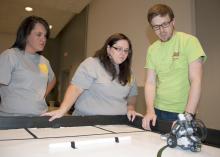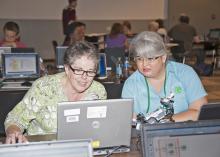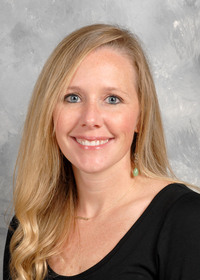Information Possibly Outdated
The information presented on this page was originally released on August 14, 2013. It may not be outdated, but please search our site for more current information. If you plan to quote or reference this information in a publication, please check with the Extension specialist or author before proceeding.
Robotics academy trains state's robotics instructors
MISSISSIPPI STATE – Although robots do dangerous and repetitive tasks and provide automation in industry, it was their role as really good teaching tools that drew trainers to Mississippi State University in early August.
The MSU Extension Service’s Center for Technology Outreach hosted the 4-H Robotics Academy Aug. 11-15. The center partnered with NASA and the University of Mississippi’s Center for Mathematics and Science Education to offer five days of robotics training at basically no charge. MSU’s Bagley College of Engineering was also involved.
Instructors from NASA and Carnegie Mellon University trained 58 participants in two robotics programming languages and then helped as participants learned how to use these languages to operate their robots. Tim Friez, a software engineer at Carnegie Mellon University, taught ROBOTC, a language he developed with another Carnegie Mellon programmer. Emma Seiler, assistant K-12 projects coordinator with NASA’s Stennis Space Center, taught NXT-G, a graphics-based language.
Mariah Smith, Extension assistant professor and Robotics Academy organizer, said robotics is an important part of students’ education today.
“According to the Mississippi Department of Agriculture and Commerce, 29 percent of the Mississippi workforce is involved in agriculture,” Smith said. “Agriculture is increasingly technical and relies more and more on robots, so it’s imperative that we help our students prepare for that future.”
The 4-H Robotics Academy brought together 4-H robotics club volunteer leaders, youth leaders, vocational teachers and others who teach robotics to students. They soaked up intense instruction time and then translated it into successful operation of smaller, plastic robots or larger, metal robots.
Monica Morel, volunteer leader of the Gears & Gadgets 4-H robotics club in Hancock County, said she started the club to give her son a way to explore his interests. Both came for the five-day training to become better instructors for the club.
“My goal is way more than just building robots and going to competition. My primary goal is having fun, and as soon as we’re not having fun, we revamp,” Morel said. “We want to have fun, but we also want to learn something.”
She also said that robots -- specifically, teaching others how to program and operate robots -- have an additional social benefit.
“Engineering kids don’t speak much to each other; they don’t communicate with words,” Morel said. “If the younger kids have questions, I tell them to ask the youth leaders. My rule is you are never allowed to touch the robot while you’re teaching, so you have to make your words explain it. If they learn even minimal skills of communicating with each other, then I think we’ve improved.”
Friez and a colleague developed the ROBOTC language as a way to teach computer science using robotics systems. He incorporates instructional theory and teaching techniques into his workshops.
“We’re not just asking what can you teach with robotics, but how can you teach with robots?” Friez said.
He said robotics is an ideal way to teach science, technology, engineering and mathematics, the STEM subjects.
“You can teach previously abstract concepts, such as the circumference of a circle,” Friez said. “It’s no longer a problem on paper in math class, but now it’s the distance this robot will travel because of the size and circumference of its wheels.
“The pen-and-paper concepts are translated to real life,” he said.
Seiler said hands-on learning and tangible results make robotics classes successful.
“You get to build something and make it do something,” Seiler said. “With robotics, kids want to learn more, and they’re excited about it.”
Mannie Lowe, program manager for UM’s Center for Mathematics and Science Education, said robotics has found a place in many youth clubs and elementary and secondary school classrooms across the state. Competitions drive many of the participants to learn more and expand their skills.
“Robotics is a great tool for teaching STEM classes,” Lowe said. “You get to teach the kids a concept and see the light bulbs go on as they understand.”






